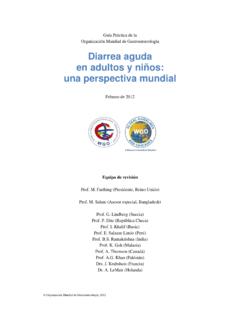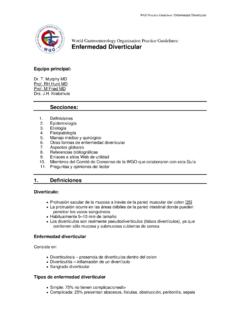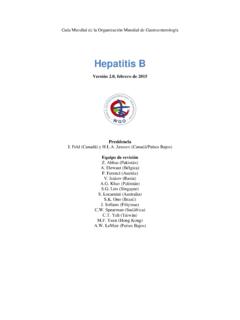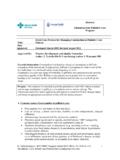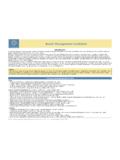Transcription of Inflammatory Bowel Disease
1 World Gastroenterology Organisation Global Guidelines Inflammatory Bowel Disease Update August 2015 Review team Charles Bernstein Canada (Chair) Abraham Eliakim Israel Suliman Fedail Sudan Michael Fried Switzerland Richard Gearry New Zealand Khean-Lee Goh Malaysia Saeed Hamid Pakistan Aamir Ghafor Khan Pakistan Igor Khalif Russia Siew C. Ng Hong Kong, China Qin Ouyang China Jean-Francois Rey France Ajit Sood India Flavio Steinwurz Brazil Gillian Watermeyer South Africa Anton LeMair The Netherlands WGO Global Guidelines IBD 2 World Gastroenterology Organization, 2015 Contents 1 Introduction 3 Global incidence/prevalence and East West differences 3 Presenting features of IBD East West differences 4 2 Clinical features 5 Symptoms 5 Complications 6 3 Diagnosis of IBD 7 Patient history 7 Physical examination 8 Laboratory tests 9 Imaging and endoscopy 11 Diagnosis in pediatric patients 13 4 Cascade for IBD diagnosis 13 Cascade 1 choices for diagnosis relative to available resources 13 5 Evaluation 15 Diagnostic criteria 15 Differential diagnosis 16 6 Management of IBD 18 Introduction 18 Drugs in IBD management 20 Surgical treatment 27 Other management options 28 7 Cascades for IBD management 29 Cascade 2 UC management 29
2 Cascade 3 CD management 30 Cascade 4 perianal fistulas 31 8 References 32 Tables Table 1 Highest annual incidence rates and reported prevalence rates for Inflammatory Bowel Disease 3 Table 2 World Health Organization diagnostic criteria for Crohn s Disease 15 Table 3 Features for differentiating between UC and CD 15 Table 4 Main differential diagnoses for ulcerative colitis and Crohn s Disease 16 Table 5 Distinguishing between tuberculosis and Crohn s Disease 17 Table 6 Overview of Disease status and drug therapy 26 WGO Global Guidelines IBD 3 World Gastroenterology Organization, 2015 1 Introduction Inflammatory Bowel Disease (IBD) is a group of idiopathic chronic Inflammatory intestinal conditions. The two main Disease categories are Crohn s Disease (CD) and ulcerative colitis (UC), which have both overlapping and distinct clinical and pathological features.
3 The pathogenesis of IBD is incompletely understood. Genetic and environmental factors such as altered luminal bacteria and enhanced intestinal permeability play a role in the dysregulation of intestinal immunity, leading to gastrointestinal injury. Global incidence/prevalence and East West differences A systematic review published in 2012 [1], including data from 167 population-based studies in Europe (1930 2008), 52 studies in Asia and the Middle East (1950 2008), and 27 studies in North America (1920 2004), reported the following incidence and prevalence figures. In time-trend analyses, 75% of CD studies and 60% of UC studies showed an increasing incidence, which was statistically significant (P < ).
4 The study did not include data from South America. The incidence of CD in South America reached an average of 1 3 per 100,000 rising to 3 4/100,000 in more developed urban areas in Brazil [2]. Although there are few epidemiologic data from developing countries, the incidence and prevalence of IBD are increasing with time and in different regions around the world indicating its emergence as a global Disease . In a recent comparative population-based study from Asia, the incidence of IBD [3] was found to vary throughout Asia, ranging from per 100,000 to per 100,000 persons. In 2004 in Australia, the age-standardized (WHO World Standard Population) incidence rates of IBD, CD, and UC were , , and ,000/year, respectively [4].
5 In a population-based IBD study in Australia published in 2010 [5], the annual incidence rates were among the highest reported in the literature: per 100,000 per year. A 2009 paper [6] gave prevalence data for UC of 64/100,000 and for CD of 21/100,000 in Japan. Table 1 Highest annual incidence rates and reported prevalence rates for Inflammatory Bowel Disease Highest annual incidence (per 100,000 person-years) Highest reported prevalence values (per 100,000 persons) UC CD UC CD Europe 505 322 Asia/Middle East 114 29 North America 249 319 Australasia 145 155 The prevalence of CD appears to be higher in urban areas than in rural areas, and also higher in higher socio-economic classes. Most studies show that when the incidence first starts to increase, it is mostly among those of higher social class, but that the Disease becomes more ubiquitous with time.
6 WGO Global Guidelines IBD 4 World Gastroenterology Organization, 2015 If individuals migrate to developed countries before adolescence, those initially belonging to low-incidence populations show a higher incidence of IBD. This is particularly true for the first generation of these families born in a country with a high incidence. One hypothesis for the difference in incidence between developed and developing nations is the hygiene hypothesis, which suggests that persons less exposed to childhood infections or unsanitary conditions lose potentially friendly organisms or organisms that promote regulatory T cell development, or alternatively do not develop a sufficient immune repertoire, as they do not encounter noxious organisms [7,8].
7 Such individuals are associated with a higher incidence of chronic immune diseases, including IBD. Other hypotheses for the emergence of IBD in developing nations include changes to a Western diet and lifestyle (including use of Western approaches to medication and vaccination) and the importance of such changes early in life. In developed countries, UC emerged first and then CD followed. In the past 20 years, CD has generally overtaken UC in incidence rates. In developing countries in which IBD is emerging, UC is typically more common than CD. In India, for example, there are reports of a UC/CD ratio of 8 : 1 (previously 10 : 1). One example of the rising incidence of CD once the diseases have been prevalent for some time is seen in Hong Kong, China, where the UC/CD ratio has dropped from 8 : 1 to 1 : 1 [9].
8 The peak age of incidence of CD is in the third decade of life, with a decreasing incidence rate with age. The incidence rate in UC is quite stable between the third and seventh decades. There is a continuing trend toward an increasing incidence and prevalence of IBD across Asia (particularly in East Asia). Although this is occurring among developing nations, it is also being seen in Japan, a socio-economically advanced country. Although more females than males have CD, the incidence rates among young children have been higher in males than in females during the past decade, and over time we may see an equalization of the sex distribution. There is already a male predominance for CD in studies from East Asia. The sex ratio is already equal in UC.
9 Presenting features of IBD East West differences The presentations of CD and UC are quite similar in such disparate areas of the world as North America, South America, Europe, Australia, and New Zealand: CD is distinguished from UC by Disease proximal to the colon, perineal Disease , fistulas, histologic granulomas, and full-thickness as opposed to mucosa-limited Disease . In CD, granulomas are evident in up to 50% of patients and fistulas in 25%. However, there are also differences in presentation between the East and the West. In East Asia, there is a higher prevalence of males with CD, ileocolonic CD, less familial clustering, lower rates of surgery, and fewer extraintestinal manifestations. Primary sclerosing cholangitis (PSC) associated with UC is less prevalent.
10 Overall, the need for surgery is lower in Asian patients, at around 5 8%. However, there is a high rate of penetrating Disease and perianal Disease in Asia even at diagnosis, suggesting that complicated Disease behavior is not uncommon in East Asia [3,10 12]. WGO Global Guidelines IBD 5 World Gastroenterology Organization, 2015 In Pakistan, there is much less extraintestinal Disease in both UC and CD than is reported from the West (where up to 25% of patients have extraintestinal manifestations, if arthralgia is included). In Pakistan, few patients have perianal or fistulizing Disease . In India, the age at presentation of CD is a decade later than in the West, colonic involvement is more common, and fistulization appears to be less common.





